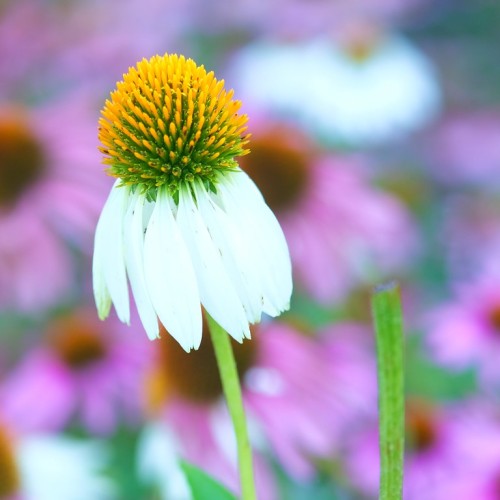
purple coneflower
Echinacea purpurea 'Finale White'
Also Known As - echinacea,purple coneflower,purple coneflowerCycle:
Herbaceous Perennial
Watering:
Minimum
Hardiness Zone:
3 - 8
Flowers:
Flowers In Summer
Sun:
Full sun
Soil:
Sandy Loamy Clay Rocky
Fruits:
Fruits In Autumn Ready In Fall
Leaf:
Yes
Growth Rate:
Moderate
Maintenance:
Low
Drought Tolerant:
Yes
Care Level:
Medium
watering
For best results, water Purple Coneflower (Echinacea purpurea 'Finale White') at least once a week, and more often if the soil is extremely dry. Be sure to water the soil, not the leaves, as too much water on the leaves can cause rot. Water deeply and slowly so that the water reaches the roots, rather than just the surface of the soil. During hot, dry weather, increase watering to twice a week, and water more if needed. Depending on the size of the plant, containers will need more frequent watering than larger gardens. Keep an eye out for wilting or drooped leaves, as they are an indication that the plant needs watering.
sunlight
Purple coneflowers prefer full sun, with 6 to 8 hours of direct sunlight per day, particularly in the morning. They can tolerate partial shade, but the stems may be weak and the plants may fail to bloom, or produce fewer flowers than if located in a sunnier spot. Morning sun is best since intense afternoon sun can dry out the soil and damage the plants’ blossoms.
pruning
As a general guide, Purple Coneflower should be pruned in late winter or early spring, before new growth appears. Pruning can help to encourage a bushier plant and remove any spent blooms from the previous season. To do this, simply cut off any dead or dying stems at the base, leaving just a few leaves at the top of each stem to encourage regrowth. Pruning can also be done in late summer, to remove any long, straggly stems that have shot up and away from the plant. Cut these back to a manageable size, leaving a few leaves at the end of the stems to encourage branching. If you wish to shape the plant, this is the time to trim any straggly side shoots or overly long stems. Always prune at a 45-degree angle, and take no more than 1-third of the plant’s height when shaping.
